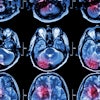
Using AI software to determine if a screening mammography exam can be read by one breast radiologist instead of two can perform comparably to double reading of all mammograms, according to a new study published on 1 August in The Lancet Oncology.
A group led by Dr. Kristina Lång, PhD, from Lund University in Sweden shared their interim analysis involving 80,000 women from the Mammography Screening with Artificial Intelligence (MASAI) trial, which is comparing traditional double reading used in Europe to a protocol that utilizes AI to initially perform risk assessment of the mammograms. In that AI-assisted group, exams deemed to be low- or intermediate-risk by the AI software would be read by one radiologist while high-risk cases would undergo traditional double reading.
The researchers found that the group of patients in the AI-assisted group had 20% more cancers detected than the group receiving traditional double reading -- without increasing false-positive cases.
"The potential benefit of AI use to detect more cancers without increasing false positives is likely also relevant for single-reading screening programs," Lång told AuntMinnieEurope.com. "Both the use of AI as detection support and the ability of AI to sort examinations in low and high risk could be useful to improve screen-reader performance."
While previous retrospective studies often suggest AI's potential in breast cancer screening, including improving mammography's accuracy, the researchers suggested that a randomized trial has not yet been led. Lång and colleagues wanted to investigate the clinical safety of AI-supported mammography and compare results with standard double-reading by radiologists per European guidelines.
In their population-based trial, the researchers included data from 80,020 women who were randomized into two groups: AI-supported screening and double reading without AI. The women had an average age of 54 years, and data related to race and ethnicity were not collected.
The team found that the AI-assisted screening group, which consisted of 39,996 women, had 244 screen-detected breast cancers, 861 recalls, and a total of 46,345 screen readings. Standard screening with double reading meanwhile (n = 40,024 women) led to 203 screen-detected cancers, 817 recalls, and a total of 83,231 screen readings.
The researchers reported other comparable findings between the two groups, including cancer detection rates, recall rates, and false-positive rates among others.
| Comparison between AI-assisted mammography and double reading | ||
| Standard double reading | AI-assisted mammography | |
| Cancer detection rate (per 1,000 screened women) | 5.1 | 6.1 |
| Recall rate | 2% | 2.2% |
| False-positive rate | 1.5% | 1.5% |
| Positive predictive value of recall | 24.8% | 28.3% |
The researchers also reported that 184 (75%) of 244 cancers in the AI screening group were invasive and 60 (25%) were in situ. The double-reading group meanwhile saw 165 of 203 cancers (81%) deemed invasive, with the other 38 (19%) being in situ.
Finally, the team found that AI use led to a 44.3% workload decrease for reading screening mammograms.
Lång said improving screen-reader performance is "of particular interest" for the researchers, since they hypothesized that knowledge of disease prevalence will change the behavior of the radiologist in a beneficial way with fewer false positives when reading low-risk examinations and fewer false negatives when reading high-risk exams.
"We need to further investigate this potential phenomenon to see if it occurred in our trial," she told AuntMinnieEurope.com.
The study's main focus is investigating the type and stage of detected cancers in the full study population of 100,000 in the MASAI trial. Lång said the team wants to understand if there is a change in the panorama of detected cancers when screening with the support of AI.
In an accompanying editorial, Dr. Nereo Segnan from the Piedmont Reference Center for Epidemiology and Cancer Prevention (CPO Piemonte) in Turin, Italy wrote that while AI use is expected to improve screening efficiency, he noted that it's also important to acquire biological information on the detected lesions.
"An important research question thus remains: is AI, when appropriately trained, able to capture relevant biological features -- or, in other words, the natural history of the disease -- such as the capacity of tumors to grow and disseminate?" he wrote.
The full study can be found here.



















